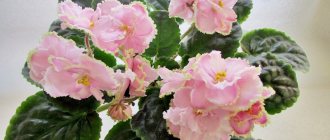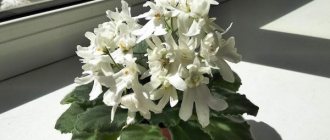Many flowers are named after women, for example, violet Natalia and Sofia Rotaru, photos and descriptions of which can be seen below. The living conditions are slightly different, but in all other respects, it is enough to provide proper care (water in a timely manner, observe daylight hours, temperature conditions, humidity levels).
Violet "RM-Natalia"
One of the charming varieties. This development belongs to Natalia Skornyakova, who lives in Kursk. In 2014, this variety was presented by the breeder at the exhibition.
You can see all the beauty of the “RM-Natalia” variety in the photo.
Description
If we consider the outlet, it is of medium size. The bush strives for perfect symmetry. The leaves are oval, slightly pointed, smooth, green in color. The lower ones have slightly elongated petioles.
Features of flowering, growth and reproduction
The variety "RM-Natalia" is distinguished by a bouquet type of flowering, which looks extremely attractive. During the flowering period many large flowers appear. The corollas are simple or semi-double. The petals are wavy.
Features of care
Violets, as practice shows, respond to lighting. For example, if you increase the brightness during flowering, the buds will be larger. Flowers are grown at temperatures from +20 to +24 degrees.
Features of flowering, growth and reproduction
How long does it take to grow an adult plant?
Violet Kopeechka can be grown in 10 months.
Kopeechka is growing quickly. When growing this variety from cuttings, you will need to wait about 10 months .
The flowers are small, up to 4 cm in diameter. After opening they are light, but over time they gain richness of color.
Reproduction methods and features
Reproduction method:
- We cut off a healthy, beautiful leaf from the second tier;
- We cut the cuttings at an angle;
- We root the cuttings into the ground, the diameter of the pot is no more than 6 cm;
- Cover with a greenhouse;
- We are expecting the baby to arrive in a couple of weeks.
Leaf cuttings can be rooted in boiled water and then transplanted into the ground.
Features of flowering in hot and cool conditions
In a cool room, and the richness of the color of the flower are more clearly visible
What do flower stalks look like?
Peduncles develop from axillary buds . Long, branchy. When all the flowers have opened, they lie on the foliage.
Is it possible to achieve cap flowering?
There is no cap or bouquet flowering . The flowers fall off very quickly, not having time to form a bouquet.
Violet Kopeechka does not bloom magnificently.
Bud lifespan
Each flower then fades approximately 3 days after the bud opens.
Violet "PT-Natalie"
Another beautiful variety. Flower growers are grateful to Tatyana Pugacheva from Kursk for his appearance. For the first time this variety appeared before the general public in 2014. Let's take a closer look at the photo and description of the violet "PT-Natalia".
Description
The formation of the socket is carried out according to the standard type. The contours are uneven. This is due to the fact that the leaf petioles are much longer than required. Leaves are round in shape,
Features of flowering, growth and reproduction
This variety is distinguished by regular flowering, but, unfortunately, it cannot boast of splendor. The buds appear large in size. The petals are pink with the presence of white and purple tones.
Features of care
Problematic variety. Sports appear frequently. Requires bright and continuous lighting. Corollas may differ in shape and color. Forming rosettes is extremely difficult.
Reviews
Olga Tayurskaya, 54 years old, Ulyanovsk
I love this variety for its bright flowers and long flowering. The sockets, unfortunately, leave much to be desired.
Tatyana Ignatova, 38 years old, Orsk
I suffered for a long time, but was never lucky enough to achieve strong flower stalks. Blooms constantly.
Reviews
Dmitriy. “The variety is original, I liked it in appearance, but I had to remove it because the flowers lasted no more than three days.”
Blueberry. “There were some difficulties with rooting. But the baby, which was obtained with such difficulty, grew quickly. Beautiful, even rosette. It bloomed for the first time for three weeks. So far I like everything - both color and size. Let's see what will happen next."
Violet LE-Natalie
A distinctive feature of this variety is its delicate shades. “LE-Natalie” is the work of a famous Vinnitsa breeder. Namely, Elena Anatolyevna Lebetskaya.
Description
Medium diameter sockets. Leaves are oval and heart-shaped. There is a wavy edge. The leaf blades are green, with light green veins.
Features of flowering, growth and reproduction
Flowering cap type. A distinctive feature is the absence of a growing season. It is precisely because of the abundant and continuous flowering that gardeners like this variety so much.
Features of maintenance and care
Perhaps the most problem-free variety of violet. It is unpretentious in care, forms an exhibition rosette, has a long and abundant flowering period, and the flower stalks are quite strong. In bright light, the buds lose their brightness.
Home care
All violets require proper care.
Proper watering and fertilizing
The need for water depends on many factors :
- Light intensity;
- Air temperature and humidity;
- Age and life stage of the violet;
- The material from which the pot is made, and much more.
For violets, high-quality watering is very important . Here you need to use an individual approach. Of all the violets in your collection, only a few need watering at the moment. Others only need watering every few days.
The violet needs to be watered when the top layer of the substrate has dried, and this happens in different plants at different intervals.
Saintpaulias prefer watering in small portions . The length of the intervals between waterings is important, not the volume of water poured. Violets tolerate some dry soil more easily than excessive moisture, as this can lead to rotting of the roots and leaves.
IMPORTANT! Water the violets with soft, settled water at room temperature.
It is preferable to water from above , using a 150-200 ml syringe, or a small watering can with a long spout. With their help, we will provide a thin stream of water and protect:
- Leaves from moisture;
- And the soil from erosion.
They also practice bottom watering, immersing the pots 1/3 in water , but it is better not to get carried away with this method, since with this method there is a high risk of the substrate souring.
a great many types of fertilizers for Saintpaulias . Experts prefer liquid fertilizers. This type of fertilizer is easier to dose and can be easily combined with watering.
Basic rules for feeding violets :
- Nitrogen should predominate in the “diet” of young rosettes;
- Phosphorus is needed to set buds;
- Potassium will increase flowering time;
- The optimal choice is a complex fertilizer containing chelated forms of the main macro and microelements;
- If the plant is 2-2.5 years old, transshipment will be more beneficial for it than fertilizing.
Lighting and temperature
There should be no direct sunlight! It causes burns .
The light-flowered Kopeechka is especially afraid of direct lighting; in bright light it begins to curl its leaves. Choose window sills :
Violet Kopeechka prefers northern windows.
- Northern;
- Northeastern;
- Northwestern.
The temperature in the room where Kopeechka lives should be about 20-220 . Children and cuttings are more comfortable at temperatures of 24-250 and higher humidity.
Effect of air humidity
Saintpaulias naturally live along the banks of rivers and waterfalls; at home they need to be provided with comparable humidity . A humidity level of 60-70% will be favorable.
With regular watering and a comfortable temperature, adult plants feel good even at lower humidity (30-40%).
In winter, in conditions of air dried by radiators, the humidity level is maintained artificially . Whether it’s an air humidifier or homemade products from improvised means, the choice is yours.
Soil requirements
The soil of violets should have these properties
:
- Ease;
- Air permeability;
- Moisture capacity;
- Sufficient amount of macro and microelements;
- pH 5.5-6.5 (slightly acidic);
- Absence of pathogens and pests;
- The presence of living beneficial microflora.
IMPORTANT! Without properly selected, balanced soil, this variety of violets cannot be grown.
You can make soil for violets with your own hands.
Here is the approximate composition of the mixture for planting Saintpaulias:
- Greenword soil or high-moor peat – 5 parts;
- Vermiculite (perlite) – 2 parts;
- Sphagnum (coconut fiber) – 3 parts;
- Nutritious soil – 1 part;
- Adding crushed charcoal and dolomite flour will further improve the quality of the mixture.
The finished mixture should be :
- Light;
- Fluffy;
- Well permeable to water and air;
- Not prone to tracking.
Pruning and hygiene
To ensure that violet bushes are always beautiful and neat, they are shaped . Usually there are three tiers in the outlet. The leaves below can be carefully removed, as well as:
- Peduncles with wilted flowers;
- Yellowed, diseased, damaged leaves.
By removing the lower leaves, we gradually expose the violet stem . If necessary, sprinkle it with fresh soil.
Violets living in your home need weekly inspection . During this inspection the following is noted:
- Need for watering;
- Do I need to add substrate?
- Signs of parasites (cobwebs, wilting) and diseases (wet areas, spots);
- The need to remove leaves and flower stalks.
Dust, accumulating in the fleecy leaves of violets, harms the plant . It is washed off under the tap, protecting the soil with a bag, tying it on the pot so that water does not fall on the soil.
IMPORTANT! Each leaf is washed separately under a thin stream of warm water.
Reproduction methods
The best results are obtained by vegetative propagation by rooting leaves or stepsons, of which Kopeechka produces a lot.
The presented variety can be propagated by leaves.
Rules for transplantation and rejuvenation
to make a decision to transplant violets of the AN-Kopeechka variety if :
- Violet grows in the ground for 2 or more years;
- Roots are visible from the drainage hole;
- The violet was poured;
- There was a need to rejuvenate the plant.
all manipulations during transplantation carefully . Violets are delicate creatures.
Transfer procedure:
- Remove the root ball from the pot. (It is better if the substrate is dried);
- Remove most of the old soil;
- Trim off excessively long roots, as well as old, damaged roots;
- Place the violet in the new substrate;
- After 24 hours, water the plant and, if necessary, add soil.
IMPORTANT! The pot size remains the same!
Kopeechka is rejuvenated when the plant is 2.5-3 years old . The “head” of the plant (the growing point and 2 tiers of leaves) is cut off and rooted in a greenhouse.
Violet RS-Natalie
There are a large number of magnificent violets and the RS-Natalie variety is no exception. Svetlana Nikolaevna Repkina was engaged in selection work. She is originally from Lugansk.
Description
The rosette is aligned, the contours are surprisingly symmetrical. The bush grows of medium size, which is why it belongs to the standard type. The leaves are round in shape. The edge is wavy-jagged.
Features of flowering, growth and reproduction
Flowering is carried out according to the bud type. Quite large and heavy terry buds are formed on the flower. The petals are painted in delicate pink shades. Along the contour of each petal there are raspberry inclusions.
Features of maintenance and care
This variety is unpretentious. The growth is easy, the rosette is formed correctly, the flowering is long and lush. The only nuance that should be taken into account is that violets take a long time to prepare for the flowering period.
Violet Deo-Natalie
One of the extraordinary varieties. Flower growers are grateful to the breeder Olga Nikolaevna Aksenkina for its appearance. The flower first appeared in 2009.
Description
As the plant grows, it forms rosettes of impressive size. The bush has a neat configuration, the contour is as smooth as possible. The leaves are oval-shaped and have a rich green color with swampy reflections.
Features of flowering, growth and reproduction
During the flowering period, the plant blooms large buds with double and semi-double fullness. The edges of the petals are wavy. The buds grow in neat tiers, located one above the other.
Features of maintenance and care
This variety is suitable for all gardeners, regardless of their experience. Violets are easy to care for. The flowering period is quite long and abundant. One of the issues is that sometimes the socket tries to pull out.











